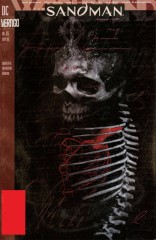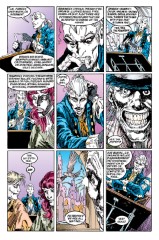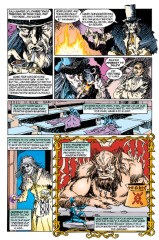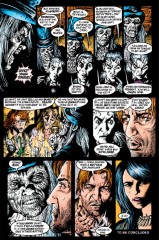Issue 55: "Cerements"
Neil Gaiman, Shea Anton Pensa, Vince Locke, Bryan Talbot, Mark Buckingham
- Fifth story in anthology, Worlds' End
- Fifth story reprinted in trade paperback Worlds' End
- Audible Act III Chapter 18
Page 1#
Panel 6
Brant is counting to try to determine how far away the lightning struck. The rule of thumb is one mile for each five seconds elapsed between the flash and the thunderclap.
Page 2#
Panel 8
"Petrefax" is Latin-derived, and means either "one who turns things to stone" or else "thing made of stone". "Kyrielle" is from the Greek "Kyrie", "Lord". "Eucrasia" is an obsolete medical term for "good health" and derives from Greek "eu", "good" and either "krasis", "mixture", or "krasi", "temperature".
Page 4#
- Earth, Fire, Water and Air (or sometimes Wind), were four of the Five Elements in medieval times. The Fifth Element (which is also referenced in the film of the same name), is variously named as Life, Quintessence ("fifth essence" in Latin), or The Void (in Miyamoto Musashi's Go Rin No Sho, or The Book of Five Rings). Naturally, the Necropolitans would also bury their "Clients" in accordance to the Five Elements (with Mummification replacing Life /The Void/Quintessence).
Page 5#
Panel 2
Polycarp: from Greek "poly", "many", and "karpos", "fruit".
Page 7#
Panel 1
Air burial is practiced in Tibet, just as we see it depicted here, including the eating afterwards, although not the storytelling.
Page 9#
Panel 3
Similar to stories of people starting work in ship's engine rooms being sent to find a left-handed monkey wrench.
Panel 8
A story within a story within a story...
Page 12#
Panel 4
Ironic that Scutt's family should have to hang him (albeit about the chest) in order to prevent him from being hung (from the neck).
Page 14#
Panel 3
All but the very newest readers will recognize this as Dream's wayward brother, Destruction.
Page 15#
Panel 4
And here, a story within a story within a story within a story.
Page 16#
Panel 1
Looking at the six figures of the Endless in the foreground, the missing one seems to be Despair. It was mentioned in issue #48 that Despair had died and been replaced.
Page 17#
Panel 2
"Sithcundman" is an old title of rank for a king's companion, probably Old English.
Page 19#
Panel 2
Angkou: According to A Dictionary of Ghost Lore, by Peter Haining, an ankou, or "graveyard watcher", is a ghost that guards cemeteries, and there are ankou stories from all over Europe. Whenever a new graveyard was created centuries ago, it was the custom to bury some unfortunate person alive in the first grave. The ghost of this person became the ankou -- frightening off anyone or anything, living or dead, that would disturb the peace of the graveyard.
Panel 6
It only makes sense for a city populated entirely by morticians to put morticians in their fairy tales, I suppose... The runes on the cup include "th", "r", "s", and "e" as the first, fourth, fifth, and sixth respectively. The third might be a "u". I can't identify the second at all.
Page 20#
Panel 1
A recursion: the fourth-level story is identical to the top-level framing tale.
Page 21#
Panel 4
Somewhat reminiscent of Exodus 4:6-7, in which Moses' hand is transformed and then restored as a proof of God's power.
Page 23#
Panel 7
Bagulkal: This word, which seems to be a corruption of the Hebrew, appears in Masonic encyclopedias: (emphasis added)
A significant word in the high degrees. Lenning says it is a corruption of the Hebrew Begoal- kol, meaning all is revealed, to which Mackenzie demurs. Pike says, Bagulkol, with a similar reference to a revelation. Rockwell gives in his manuscript, Bekalkel, without any meaning. The old rituals interpret it as signifying the faithful guardian of the sacred ark, a derivation clearly fanciful.
So in this case, Bagulkal could be the name of the entity guarding the cerements (on page 20.)
Page 24#
Panel 7
Several netters had speculated exactly this. Gaiman has stated that he drew inspiration from old horror anthology movies; the punchline at the end of the framing story was often that the characters were dead.
Credits
- Greg "elmo" Morrow (morrow@physics.rice.edu) created the Sandman Annotations and forwarded much useful information about "Worlds' End". He also corrected the lightning-distance rule of thumb.
- Originally collated and edited by David Goldfarb.
- Col. G. L. Sicherman (gls@hrcms.att.com) commented on the journeymen's names and referenced "sithcundman".
- Kenneth Chang (kchang@ncsa.uiuc.edu) referenced Tibetan funeral customs.
- Andrew Solovay (solovay@netcom.com) noted the Biblical story.
- Lance "Squiddie" Smith (lsmith@cs.umn.edu) relayed information concerning Amicus horror films.
- Julie LaBomascus referenced "Angkou" via Byron Go (byron@netcom.com).
- Ralf Hildebrandt added more details.
- Richard Munn added the Bagulkal reference.
Last modified by Richard Munn on 2023-08-15 - Updated issue inclusion blocks, adding extra trades, and audible/netflix episodes
[edit this page] [page history]
















